Weight Loss can be a frustrating business. You have to eat healthily, start exercising and then wait. And wait, and wait and, sometimes, wait some more. Sometimes you see a little progress and, other times, nothing seems to be happening. So, if you’re exercising and you’re watching your calories, why isn’t the scale moving?
1. When Will You Start Losing Weight?
Short answer: There’s no firm answer to this question because there are so many elements involved with weight loss and each person will have a different experience. If you’ve reduced your calories by about 500 calories a day with diet and exercise and are consistent with that every day, you will theoretically lose about a pound a week. However, there are other factors involved in weight loss, some of which you can’t control including gender, metabolism, weight, age, fitness level, and hereditary factors. It’s hard to let your body respond in its own time, but that’s exactly what we have to do and it helps to:
- Focus on what you can control: You can control what you eat, how often you move, how you deal with stress and how well you take care of yourself each day. Doing the best you can with each of those will put you on the right track.
- Forget about what you can’t control: You can’t do anything about the things that may make it more difficult to lose weight, such as genetics, age, gender and body type. How much these things play a role in your success isn’t clear, but you know you can eat better and exercise more, two things that can help you lose weight.
- Ditch the scale: If getting on the scale makes you crazy, put it aside for a while or only weigh yourself every once in a while. A scale can’t tell you how much body fat you’re losing, so take your measurements, get your body fat tested or use other methods of tracking your progress. Find ways to encourage your success and that makes you feel good about what you’re doing.
- Focus on the results you are getting: Are you feeling better? Walking faster or longer? Getting stronger? Sleeping better? More energetic? That’s progress and there may be other health benefits to keep you motivated.
2. Why Can’t You Get Rid of Your Belly and Thighs?
Many people find that, even when they lose body fat, some areas never seem to slim down (i.e., the belly, hips, and thighs). If you’ve been doing a zillion crunches on your quest for six-pack abs, remember:
- Spot training doesn’t work: You can’t do crunches to reduce your belly fat or leg lifts to reduce cellulite around the thighs.
- To slim down, you have to lose body fat: Cardio, weight training, and diet are three crucial components to losing fat.
- Even losing body fat doesn’t guarantee perfection: Your body decides where and when it loses fat, not you. Do your best with your exercise and diet and allow your body to respond to that.
- Focus on the positive results: Maybe you’d rather lose an inch around your belly than, say around your forearm or calf, but progress is progress. If you’re losing inches, you’re on the right track and your body will eventually get around to those more stubborn areas if you’re consistent and patient.
3. You Don’t see Weight Loss…What Are You Doing Wrong?
Plateaus happen to everyone. When you do the same exercise over and over, your body adapts to it and your workout becomes less effective. If you’ve reached a plateau try these ideas:
- Increase your exercise intensity: Speed up your usual workout or try interval training to boost your endurance and calorie-burn.
- Try something new: Confuse your body by doing something you’ve never done—ride a bike or go for a swim to keep your muscles from becoming too accustomed to one exercise.
- Lift weights: If you’re not weight training, start with a basic strength training program 2-3 times a week. Adding muscle will increase your metabolism and help you lose body fat. If you are lifting weights, try changing your program regularly so that you challenge your muscles in different ways.
- Add another day of exercise: Even an extra 15-20 minutes a week can help you burn more calories.
4. Why Have You Been Exercising for Months and You Don’t See Weight Loss?
If you’re using a scale, may we again recommend that you set it aside and use other methods to track your progress? A scale can’t tell you what you’re losing or gaining. If you’re following a complete program, you may actually be gaining muscle rather than fat.
- Even if your weight goes up, you may still be losing body fat: Muscle is more dense than fat and it takes up less space. Pay attention to how your clothes fit–if you weigh more but have slimmed down, you’re on the right track.
- Take Your Measurements: Use a measuring tape to measure your chest, waist, hips, arms, and thighs. Every four weeks or so, re-take them to track your progress. If you’re losing inches, again, you’re on the right track.
- If you’ve gained weight and haven’t slimmed down, look at your diet: Some people compensate for exercise by eating more, thinking that exercise gives them permission to eat what they want. You may also be resting more after working out than you normally do, which can change how many calories you burn daily. Keep a journal of what you eat and how much activity you get to track what’s going in and what’s going out.
5. How Can You Keep Going When Haven’t Seen Results?
Focusing on weight loss is a sure way to get frustrated. Giving up on weight loss and focusing on other benefits may keep you going when times get tough. Just a few benefits of exercise include:
- More energy
- Better sleep
- More focus and concentration
- Increased circulation
- Reduced stress
- More confidence
If you’re frustrated with lack of results, plateaus or other weight-loss dilemmas, remember that losing weight takes time, patience and consistency. It can take months or years to see significant changes so, when you feel like quitting, remember that what you’re doing now will affect your future quality of life.
Joining a gym can be a difficult task. Not only are you taking on the physical challenge, but there are also emotional, mental and financial elements that go along with it.
Before taking advantage of the latest sales promotion at a local gym, be sure to do your homework.
Call or visit gyms within a 10KM radius of your home or work (you’re more likely to succeed if your gym is close to home) and ask these 5 questions before you join.
1. Do I have to sign a contract when joining a gym?
Most gyms will make you sign a 1 year contract without giving you an option to get out of the contract. This is not an ideal situation as life always presents challenges that might affect your attendance at the gym. If you have to move or if you change jobs, you don’t want to be stuck in a contract.
Be sure to ask what happens at the end of your contract. Most gyms automatically renew your contract. Make sure you have an opt out agreement after 12 months if you do end up signing a contract.
2. What’s your guest policy?
It’s common practice for gyms to charge a daily entry fee for guests. Make sure you know what the guest charge is at your gym and how frequently you can bring guests.
3. What’s included in the membership cost?
Many gyms advertise a low sign up fee or monthly rate only to add-on more fees for other services and amenities once you join. If towel service, classes or coaching is important to you ask what these services cost on top of your monthly fee. Ask for a fee breakdown.
4. Is someone available to show me how use the equipment or prescribe me a program?
When you sign up for a gym membership, most of the time this just buys you ‘access’ to the gym. If you want someone to show you how the equipment works or all the ins and outs of the facility, that may cost you extra – usually in the form of a personal training session which can get costly. Smaller gyms tend to have better customer service and ratios of members to trainers which means you’ll probably get this included in your membership.
5. I am joining a gym, can I try the gym before signing up?
There should be no reason for you not to be able to try the gym before joining. However, be ready to have some ID handy or proof of residency as most gyms will require this to ensure that you are local and not a tourist looking for a “free pass”. Most gyms will allow locals you to try their gym for at least one workout.
Top 10 fitness Questions answered
Many people have fitness questions about their workouts and fitness. Whether broad questions or more advanced, here are some of the most common fitness questions answered for you!
Should I work out every day?
Believe it or not, working out every day is not necessary to see progress, with many experts suggesting that workout routines add a rest day or two to help prevent soreness and give the body more time to recover- even helping to prevent injury. That said, it is important to keep light exercise even on rest days, whether just a quick walk around the neighborhood or a few simple stretches.
How long can I stick to the same routine?
You may wonder, “Why fix what’s not broken?”, however, it is important to mix up your routine for a variety of reasons. Primarily, it can help prevent your body from getting used to the same routine and prevent stalls in progress. In addition, it is often good to re-evaluate your goals and adjust your routine so that you see results where you want to the most.
Is there a “best” type of diet to follow to see results?
Much like there is not a one-size-fits-all workout routine, the best diet for your goals might be different from that of another. It is important to research what types of diets work best for you and your goals or consult with a professional that can help you evaluate your individual needs.
I don’t want to become too bulky- do I need to do muscle training?
Most people who bulk up work extremely hard to gain their musculature, so there is no need to worry about doing so accidentally! Muscle training is good for people with various goals and should be incorporated in some capacity to make a well-rounded routine.
I want to lose weight quickly- what workouts are best for me?
Cardio workouts, particularly those that have a high-calorie burn rate, are the best for weight loss. However, be warned that weight loss requires changes to both diet and exercise to be successful.
What is the best way to deal with sore muscles?
Relaxing in a warm bath with Epsom salts, using a foam roller to gently massage muscles, and using a heating pad are surefire ways to ward off soreness. A good night’s rest is also an excellent way to help you recover!
How long should my work out last?
While time spent working out will vary based on your goals and needs, typically at least 30 minutes is a good goal post with an hour being closer to ideal.
How long do I need to wait to see results?
Typically, 6 –8 weeks (about 2 months) is when you’ll typically begin to notice results, although the extent of the results will often vary based on your particular routine, how closely you stick to it, and the degree of intensity you subscribe to. However, it’s important to focus on long-term sustainable changes, so be prepared for it to be a longer work in progress!
How intense should my workouts be?
While at least moderate intensity is probably the best, any increase in activity can provide benefits. Routines should be adjusted as needed- but it doesn’t necessarily hurt to start small and increase intensity as time goes on.
What is the best way to evaluate my needs?
Often, whether establishing new goals or updating old ones, it is good to check in with your current routine and diet to see whether they still support your current goals, or how they may be adjusted to suit new ones. It may benefit you to have an unbiased, educated third party, such as a personal trainer, assist with this sort of evaluation as they can give more specific insights tailored to your situation.
Have more questions or want specially tailored advice to suit your fitness needs? Consider setting an appointment with one of our certified personal trainers today at (843) 663-3900.
Warm up: A Smart start to your workout
- Warming up before exercise increases blood flow to your muscles and raises your body temperature.
- This can improve your performance and decrease your risk of injury.
- To warm up before you work out, do low-intensity exercise for five to 10 minutes.
- Try activities like walking, jogging or jumping jacks.
- Instead of static stretches, do dynamic stretches, which get your body moving.
This winter, whether you’re determined to workout outside even when it’s freezing or want to stick to the comfort of your at-home gym (aka your living room, bedroom or garage), there’s one important step before you start: your warmup.
Dr. Alison Putnam, a physician at the Sports Medicine Clinic at Ballard, explains how to effectively warm up for exercise — and why it’s so important to get your muscles warm before you work out.
How to warm up
While “warming up” might incite thoughts of reheating leftovers in the microwave, it also refers to getting your body ready for exercise.
“When you warm up, you’re working on improving blood flow to muscles and warming up muscle tissue,” says Putnam. “You usually want to do some form of low-intensity work that prepares you for the exercise you’re going to do.”
For instance, if you’re planning on going for a run, a low-intensity exercise that would properly warm you up is a slow jog. If you’re doing a strength workout such as weightlifting or Pilates, start with some jumping jacks to increase the blood flow to your muscles.
Other low-intensity warmups include going for a quick walk, pedaling on a bike, doing a few pushups or moving through some yoga poses.
Think of your warmup activity as movement that sightly elevates your heart rate and gets you working up a light sweat (as my favorite workout instructor calls it, “that glazed doughnut look”).
“Aim to warm up for around five to 10 minutes before you start your workout,” adds Putnam.
The dos and don’ts of stretching
If you were taught to do static stretches — where you sit and hold a stretch for what feels like minutes on end — before working out, try dynamic stretching instead.
“Static stretches are not helpful before you work out,” says Putnam. “Dynamic stretching is better for warming up because it’s a stretch that involves motion.”
Three dynamic stretches that she suggests incorporating into your warmup routine:
Hamstring. To loosen up the back of your legs, stand with your feet on the ground and hinge at your hips, slowly bending over and then standing back up. Your legs should be straight, but don’t lock your knees.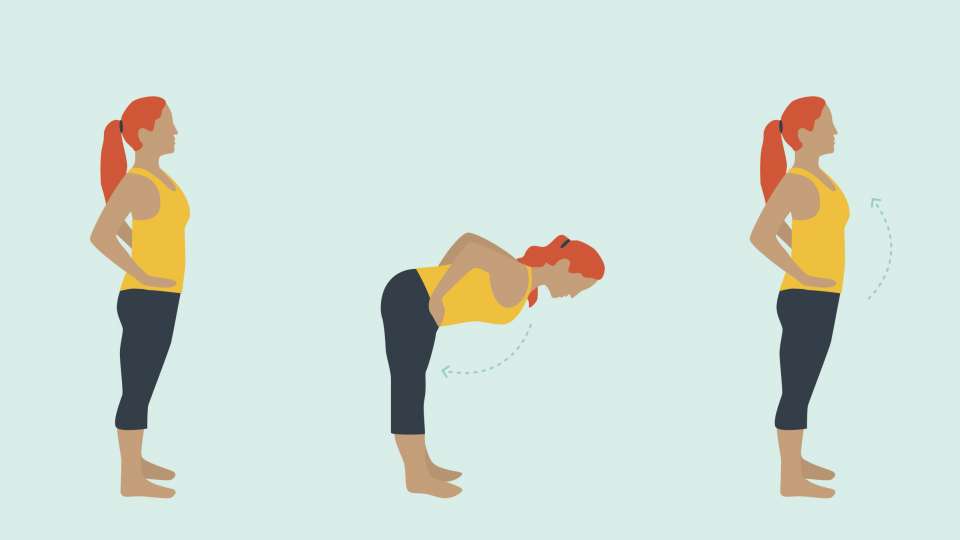
Adductor. To loosen up the inside of your legs, walk your feet out into a wide stance with your feet facing forward and slowly lunge from side to side. Your knee should not go past your toes each time you lunge.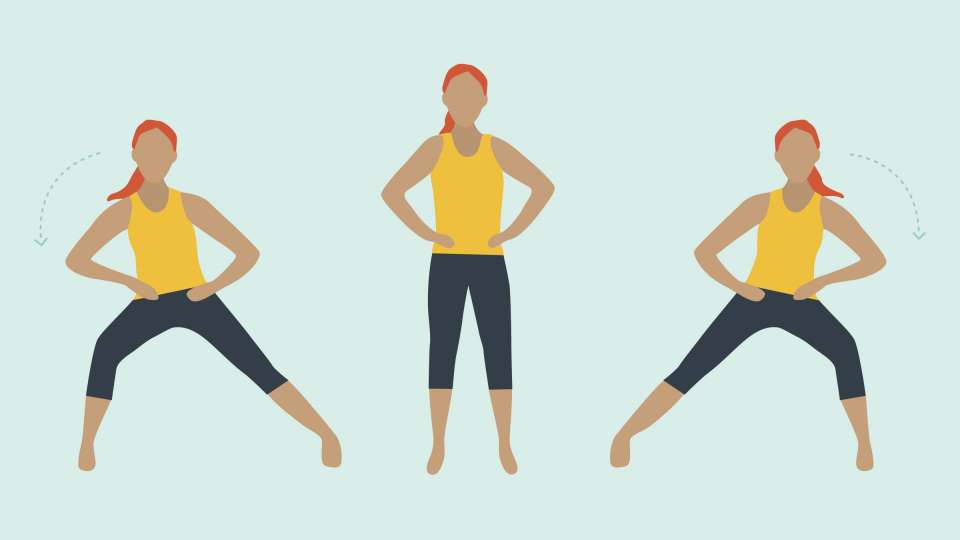
Chest and arms. To warm up your arm and chest muscles, grasp your hands behind your back and while keeping your arms straight, slowly raise your clasped hands up and back down. If you can’t reach your hands, use a strap to connect your hands behind your back. 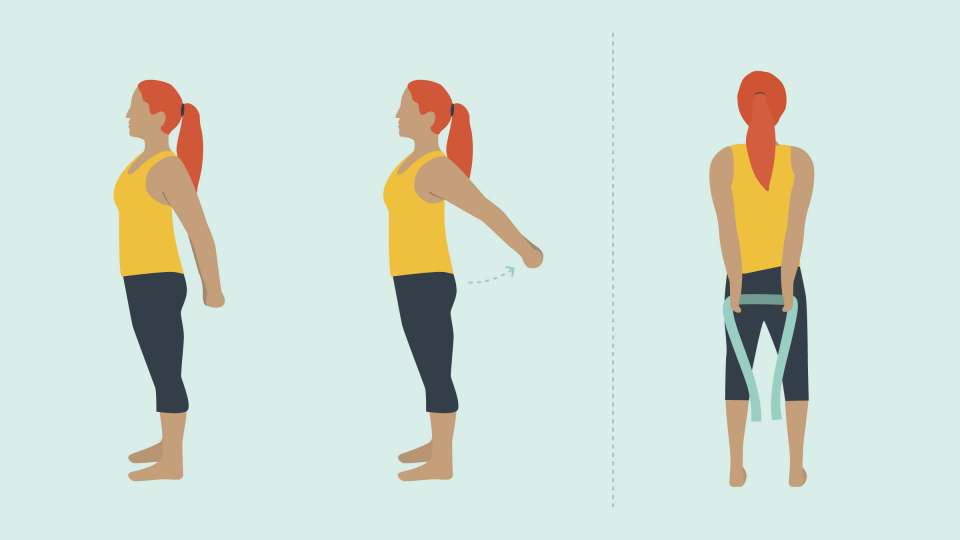
Do each dynamic stretch for 30-60 seconds. Then, do some low-intensity work for a few minutes and get going on your workout.
Why warming up is important
The benefits of warming up go far beyond looking like a glazed doughnut.
“Increasing your blood flow and the temperature of your muscles can increase your range of motion and decrease stiffness, which we think can contribute to decreased injury,” says Putnam.
While results from studies that look at whether or not warming up reduces the risk of injury are somewhat inconclusive, the majority of evidence is in favor of warming up before exercise to decrease the risk of injury.
And with good reason: Jumping (literally) right into your workout without warming up your muscles is like trying to stretch a frozen rubber band. It’s more likely to snap or break, whereas a warm rubber band is stretchy and flexible.
“We also think that warming up can improve your performance,” adds Putnam.
Studies show that elevating your body temperature during a warmup increases the sensitivity of nerve receptors as well as the speed of nerve impulses. In other words, it gets your whole body — mind, muscles, nerves — turned on so that you’re ready to go and give it your best during your workout.
On top of all that, Putnam notes how a good warmup and workout can improve your mental health, too.
“Warming up and exercise in general increases your relaxation and concentration, which is helpful — especially during a pandemic.”
Even more reason to include a warmup before your next workout

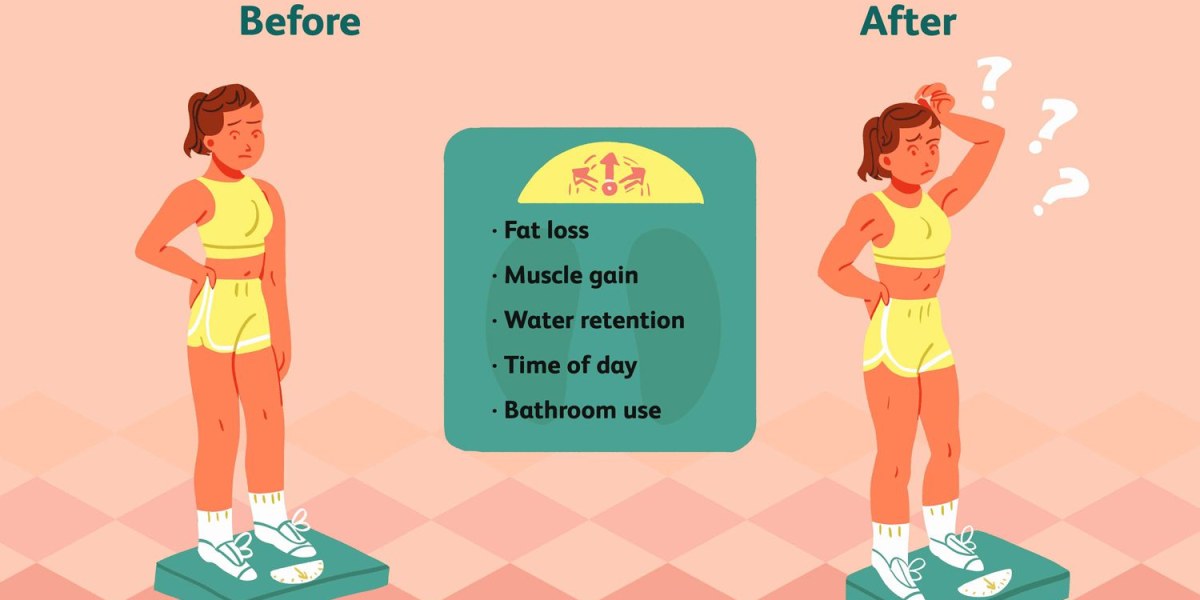


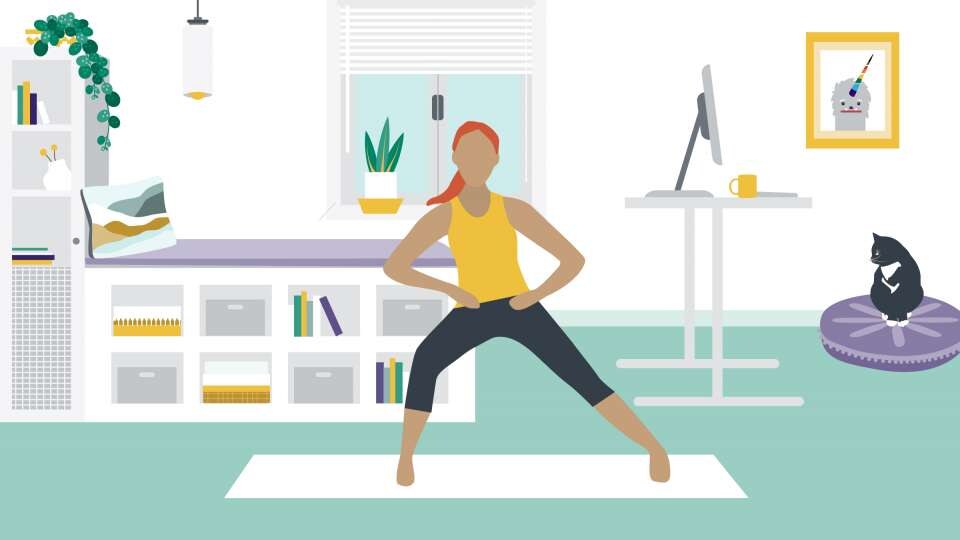

Recent Comments